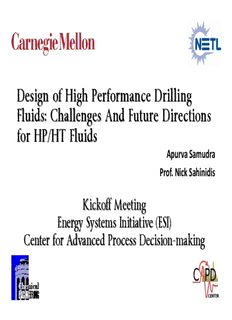
Design of High Performance Drilling Fluids: Challenges And Future PDF
Preview Design of High Performance Drilling Fluids: Challenges And Future
DDeessiiggnn ooff HHiigghh PPeerrffoorrmmaannccee DDrriilllliinngg Fluids: Challenges And Future Directions ffoorr HHPP//HHTT FFlluuiiddss Apurva Samudra Prof. Nick Sahinidis Kickoff Meeting EEnneerrggyy SSyysstteemmss IInniittiiaattiivvee ((EESSII)) Center for Advanced Process Decision-making Deep Drilling World energy demand continuously increasing o TToottaall eessttiimmaatteedd ccoonnvveennttiioonnaall ggaass rreessoouurrcceess aatt o depths > 4.5 km = 844 TCF No. of deep wells disproportionately small o compared to their potential Costs are an order of magnitude higher Higgh costs limit the number of deepp wells Drilling amounts to 50% of the total well costs Last 10‐20% of the bore hole can account for 50% of the total cost 2 Drilling Process A A Drill pipe E B Drill stringg B C Drill bit F D Rock cuttings E Annulus D F Solid separattiion devices C Source: Schlumberger Excellence in Educational Development (SEED) 3 Drilling Cycle Turbulent zone Drill pipe Propertiies addjjustedd o Hiighh shhear zone with additives o High temperature PPrrooppeerrttyy Driillll bbiit Adjustment o Laminar flow Shale shakers, o Filter‐cake Solids Well centrifuges etc. with formation control annulus Low shear rate oo CCuuttttiinnggss ttrraannssppoorrtt 4 Functions of Drilling Fluids Remove and transport drilled cuttings o RReemmoovvaall iinnccrreeaasseess rraattee ooff ppeenneettrraattiioonn Cool and lubricate the drill bit o Increase lifespan of the bit Seal the wall in permeable formations o Form a filter cake to reduce loss of circulation CCoonnttrrooll pprreessssuurree iinn tthhee ddrriilllleedd ffoorrmmaattiioonn oo Stability and efficiency affected greatly by pressure MMaannaaggee ggaass kkiicckkss, ffoorrmmaattiioonn lliiqquuiidd iinnvvaassiioonn eettcc. 5 Functions of Drilling Fluids Minimize reservoir damage o PPeerrmmiitt ffoorrmmaattiioonn eevvaalluuaattiioonn o Maintain well‐bore stability o Prevent corrosion and excessive wear o FFaacciilliittaattee cceemmeennttiinngg aanndd ccoommpplleettiioonn oo Inhibit gas hydrate formation o Neutralize corrosive gases encountered o 6 Components of Water-based Muds Water Freshwater, seawater, brines Base fluid Inert Soluble Other minerals TThhiinnnneerrss, salts, … Reactive Water‐based Smectite mmuuddss Mud system High density WWeeiigghhiinngg mmaatteerriiaall,, Solids insoluble salts Drilled cuttings LLooww ddeennssiittyy Clays, polymers 7 Components of Non-aqueous Muds Base fluid Esters, diesel, mineral oils External synthetic fluids like olefins, pphhaassee SSoolluubbllee aaddddiittiivveess Surfactants, rheology modifiers, Internal phase Non‐aqueous thinners, Lime, glycols, acetates, MMuuddss nitrates Mud system Organophillic clays, weight material, CaCO 3 Solids DDrriilllleedd cuttings 8 HP/HT Drilling Challenges Meet the demanding conditions o DDeepptthhss >> 2200000000 fftt , PPrreessssuurreess uupp ttoo 22000000 bbaarr, Temperatures up to 250°C AAtt eexxttrreemmee ccoonnddiittiioonnss llooww RROOPP lleeaaddss ttoo hhiigghh oo costs Addddiitiive ddegradde Mud breaks down Mud behavior difficult to predict Performance vs. Environmental acceptance o 9 Design Process Formulate ooIIddeennttiiffyy ppoossssiibbllee ooDDeevveelloopp oAssess current algorithms to additives muds span the search oFormulate ooDDeeffiinnee nneeeeddss ssppaaccee property moddells Asses Design 10
Description: